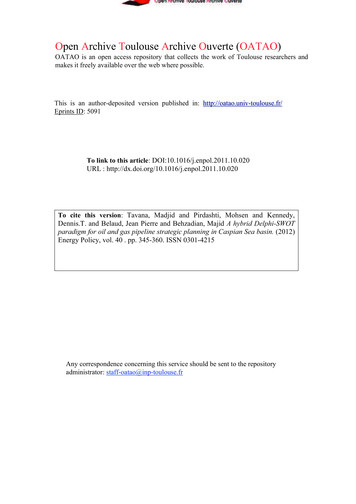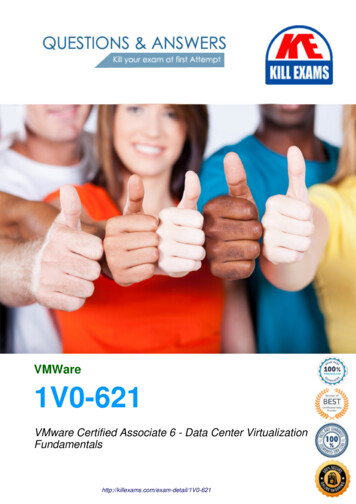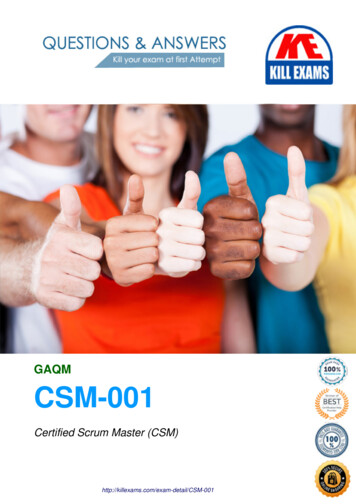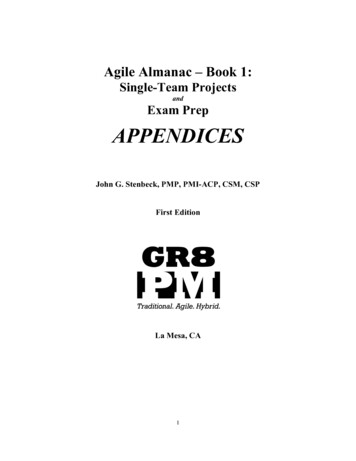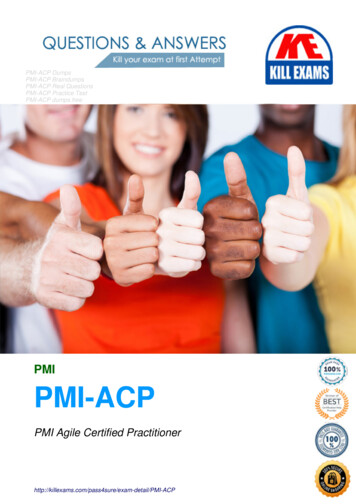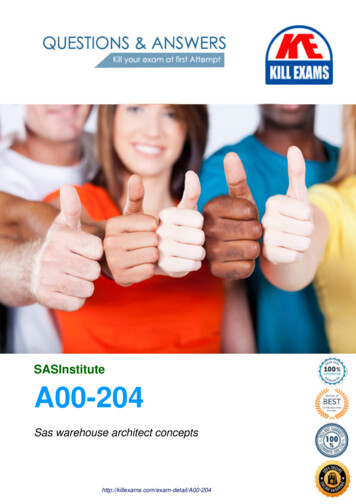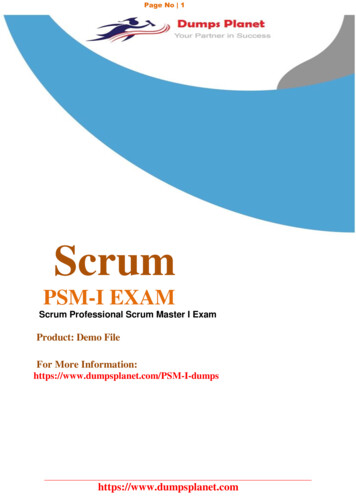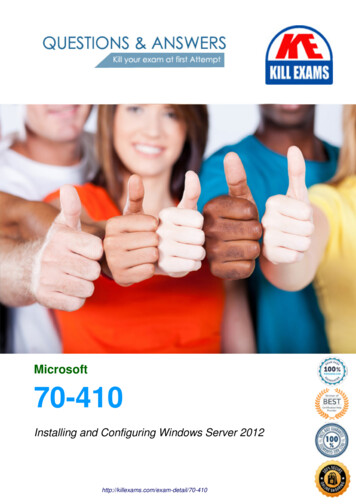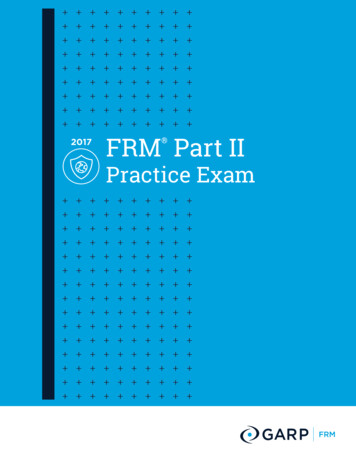
Transcription
2017FRM Part II Practice Exam
Financial Risk Manager Examination (FRM) Part II Practice ExamTable of ContentsIntroduction to 2017 FRM Part II Practice Exam . 22017 FRM Part II Practice Exam – Statistical Reference Table . 42017 FRM Part II Practice Exam – Special Instructions and Definitions . 52017 FRM Part II Practice Exam – Candidate Answer Sheet . 62017 FRM Part II Practice Exam – Questions . 72017 FRM Part II Practice Exam – Answer Key . 412017 FRM Part II Practice Exam – Answers & Explanations . 42VER 11/18/16 2016 Global Association of Risk Professionals. All rights reserved. It is illegal to reproduce this materialin any format without prior written approval of GARP, Global Association of Risk Professionals, Inc.
Financial Risk Manager Examination (FRM) Part II Practice ExamIntroductionThe FRM Exam is a practice-oriented examination. Its questions are derived from a combination of theory, as set forth in thecore readings, and “real-world” work experience. Candidates are expected to understand risk management concepts andapproaches and how they would apply to a risk manager’s day-to-day activities.The FRM Exam is also a comprehensive examination, testing a risk professional on a number of risk management conceptsand approaches. It is very rare that a risk manager will be faced with an issue that can immediately be slotted into onecategory. In the real world, a risk manager must be able to identify any number of risk-related issues and be able to deal withthem effectively.The 2017 FRM Part I and Part II Practice Exams have been developed to aid candidates in their preparation for the FRM Examin May and November 2017. These Practice Exams are based on a sample of questions from prior FRM Exams and aresuggestive of the questions that will be in the 2017 FRM Exam.The 2017 FRM Part I Practice Exam contains 100 multiple-choice questions and the 2017 FRM Part II Practice Exam contains80 multiple-choice questions, the same number of questions that the actual 2017 FRM Exam Part I and 2017 FRM Exam PartII will contain. As such, the Practice Exams were designed to allow candidates to calibrate their preparedness both in terms ofmaterial and time.The 2017 FRM Practice Exams do not necessarily cover all topics to be tested on the 2017 FRM Exam as any test will samplefrom the universe of testable possible knowledge points. However, the questions selected for inclusion in the Practice Examswere chosen to be broadly reflective of the material assigned for 2017 as well as to represent the style of question that theFRM Committee considers appropriate based on assigned material.For a complete list of current topics, core readings, and key learning objectives candidates should refer to the 2017 FRMExam Study Guide and 2017 FRM Learning Objectives.Core readings were selected by the FRM Committee to assist candidates in their review of the subjects covered by the Exam.Questions for the FRM Exam are derived from the core readings. It is strongly suggested that candidates study these readingsin depth prior to sitting for the Exam.Suggested Use of Practice ExamsTo maximize the effectiveness of the practice exams, candidates are encouraged to follow these recommendations:1. Plan a date and time to take the practice exam.Set dates appropriately to give sufficient study/review time for the practice exam prior to the actual exam.2. Simulate the test environment as closely as possible. Take the practice exam in a quiet place. Have only the practice exam, candidate answer sheet, calculator, and writing instruments (pencils, erasers) available. Minimize possible distractions from other people, cell phones, televisions, etc.; put away any study material beforebeginning the practice exam. Allocate 4 hours to complete FRM Part I Practice Exam and 4 hours to complete FRM Part II Practice Exam and keeptrack of your time. The actual FRM Exam Part I and FRM Exam Part II are 4 hours each. 2016 Global Association of Risk Professionals. All rights reserved. It is illegal to reproduce this materialin any format without prior written approval of GARP, Global Association of Risk Professionals, Inc.2
Financial Risk Manager Examination (FRM) Part II Practice Exam Complete the entire exam and answer all questions. Points are awarded for correct answers. There is no penalty onthe FRM Exam for an incorrect answer. Follow the FRM calculator policy. Candidates are only allowed to bring certain types of calculators into the examroom. The only calculators authorized for use on the FRM Exam in 2017 are listed below, there will be no exceptionsto this policy. You will not be allowed into the exam room with a personal calculator other than the following: TexasInstruments BA II Plus (including the BA II Plus Professional), Hewlett Packard 12C (including the HP 12C Platinumand the Anniversary Edition), Hewlett Packard 10B II, Hewlett Packard 10B II and Hewlett Packard 20B.3. After completing the FRM Practice Exams Calculate your score by comparing your answer sheet with the practice exam answer key. Use the practice exam Answers and Explanations to better understand the correct and incorrect answers and toidentify topics that require additional review. Consult referenced core readings to prepare for the exam. Remember: pass/fail status for the actual exam is based on the distribution of scores from all candidates, so use yourscores only to gauge your own progress and level of preparedness. 2016 Global Association of Risk Professionals. All rights reserved. It is illegal to reproduce this materialin any format without prior written approval of GARP, Global Association of Risk Professionals, Inc.3
Financial Risk Manager Examination (FRM) Part II Practice Exam 2016 Global Association of Risk Professionals. All rights reserved. It is illegal to reproduce this materialin any format without prior written approval of GARP, Global Association of Risk Professionals, Inc.4
Financial Risk Manager Examination (FRM) Part II Practice ExamSpecial Instructions and Definitions1. Unless otherwise indicated, interest rates are assumed to be continuously compounded.2. Unless otherwise indicated, option contracts are assumed to be on one unit of the underlying asset.3. VaR value-at-risk4. ES expected shortfall5. GARCH generalized auto-regressive conditional heteroskedasticity6. EWMA exponentially weighted moving average7. CAPM capital asset pricing model8. LIBOR London interbank offer rate9. OIS overnight indexed swap10. CDS credit-default-swap(s)11. CCP central counterparty or central clearing counterparty12. MBS mortgage-backed-security(securities)13. CDO collateralized debt obligation(s)14. ERM enterprise risk management15. RAROC risk-adjusted return on capital16. bp(s) basis point(s)17. The CEO, CFO, CIO, and CRO are the chief executive, financial, investment, and risk officers, respectively.18. The following acronyms are used for selected lian dollarINRIndian rupeeCADCanadian dollarJPYJapanese yenCNYChinese yuanMXNMexican pesoEUReuroSGDSingapore dollarGBPBritish pound sterlingUSDUS dollar 2016 Global Association of Risk Professionals. All rights reserved. It is illegal to reproduce this materialin any format without prior written approval of GARP, Global Association of Risk Professionals, Inc.5
Financial Risk Manager Examination (FRM) Part II Practice Exam2017 FRM Part I Practice Exam – Candidate Answer .47.72.97.23.48.73.98.24.49.74.99.25.50.75.100. 2016 Global Association of Risk Professionals. All rights reserved. It is illegal to reproduce this materialin any format without prior written approval of GARP, Global Association of Risk Professionals, Inc.6
Financial Risk Manager Examination (FRM) Part II Practice Exam1.An investment bank with an active position in commodity futures is using the peaks-over-threshold (POT)methodology for estimating VaR and ES. The bank’s risk managers have set a threshold level of 3.00% to evaluateexcess losses. The choice of the threshold, they argue, is suitable and consistent with the finding that 5.00% of theobservations are in excess of the threshold value. The risk managers have concluded that the position’s VaR usingthe POT measure is 4.45% at 99% confidence level. The VaR estimate incorporates the following assumptionsgenerated from the managers’ empirical analysis:ParameterLoss thresholdNumber of observationsNumber of observations that exceed thresholdScaleShape (tail index)SymboluNnβεValue3%740370.750.22Given the VaR value and the parameter assumptions, which of the following is correct?A.B.C.D.2.Increasing the value of the tail index lowers both the ES and the VaRIncreasing the loss threshold level increases both the ES and the VaRThe value of ES is 4.57%The value of ES is 5.71%A risk manager is estimating the market risk of a portfolio using both the normal distribution and the lognormaldistribution assumptions. The manager gathers the following data on the portfolio: Annual mean: 15% Annual volatility: 35% Current portfolio value: EUR 4,800,000Trading days in a year: 252Which of the following statements is correct?A.B.C.D.Lognormal 95% VaR is less than normal 95% VaR at the 1-day holding period by 0.13%Lognormal 95% VaR is less than normal 95% VaR at the 1-year holding period by 7.91%Lognormal 99% VaR is less than normal 99% VaR at the 1-day holding period by 1.43%Lognormal 99% VaR is less than normal 99% VaR at the 1-year holding period by 13.86% 2016 Global Association of Risk Professionals. All rights reserved. It is illegal to reproduce this materialin any format without prior written approval of GARP, Global Association of Risk Professionals, Inc.7
Financial Risk Manager Examination (FRM) Part II Practice Exam3.A risk team at an investment bank uses the KMV model to estimate the distance to default and expected defaultfrequency in evaluating default conditions of both potential and existing client firms. One such client currently hastotal assets valued at USD 20 billion, asset volatility of 28% per annum, short-term debt of USD 7 billion, and longterm debt of USD 6 billion. The expected return on the firm’s assets is 5% per year and the risk free rate is 1% per year.The firm does not pay any dividends. The rating schedule at a 1-year horizon is shown in the table below:Expected Default Frequency (EDF)0.02% – 0.04%0.04% – 0.10%0.10% – 0.19%0.19% – 0.40%0.40% – 0.72%0.72% – 1.01%Rating ClassAAAAA/AA/BBB BBB /BBBBBB-/BBBB/BB-What is the suggested credit rating of the firm at a 1-year horizon using the rating schedule provided?A.B.C.D.4.AA/AA/BBB BBB /BBBBBB-/BBA risk manager is comparing the use of parametric and non-parametric approaches for calculating VaR and isconcerned about some of the characteristics present in the loss data. Which of the following conditionswould make non-parametric approaches the favored method to use?A.B.C.D.Scarcity of high magnitude loss eventSkewness in the distributionUnusually high volatility during the data periodUnusually low volatility during the data period 2016 Global Association of Risk Professionals. All rights reserved. It is illegal to reproduce this materialin any format without prior written approval of GARP, Global Association of Risk Professionals, Inc.8
Financial Risk Manager Examination (FRM) Part II Practice Exam5.LMT Bank has entered into a 1-year CDS contract with an endowment fund. According to the contract, LMT Bank willpay the endowment fund 75% of the face value of a bond issued by GTE Chemical Corporation immediately after adefault by GTE Chemical. To purchase this CDS, the endowment fund will pay LMT Bank the CDS spread, which is apercentage of the face value, once at the end of the year. LMT Bank estimates that the risk-neutral defaultprobability for GTE Chemical is 6% per year. The risk-free rate is 3% per year. Assuming defaults can only occurhalfway through the year and that the accrued premium is paid immediately after a default, what is the estimate forthe CDS spread?A.B.C.D.6.457 basis points471 basis points468 basis points628 basis pointsA risk analyst at a mid-size hedge fund is evaluating the credit risk of several trade positions. The hedge fundspecializes in corporate debt and runs a strategy that utilizes both relative value and long-only trades usingCDS and bonds. One of the new trades at the hedge fund is a BBB-rated long bond valued at JPY 10 billion.Some of the hedge fund’s newest clients, including the BBB-rate bond holders, are restricted fromwithdrawing their funds for four years. The analyst is currently evaluating the impact of various defaultscenarios to estimate future asset liquidity. The analyst has estimated that the marginal probability of defaultof the BBB-rated bond is 5% in Year 1, 8% in Year 2, 15% in Year 3, and 24% in Year 4. What is the probabilitythat the bond makes coupon payments for 4 years and then defaults at the end of Year 4?A.B.C.D.7.6%13.1%17.8%20.4% 2016 Global Association of Risk Professionals. All rights reserved. It is illegal to reproduce this materialin any format without prior written approval of GARP, Global Association of Risk Professionals, Inc.9
Financial Risk Manager Examination (FRM) Part II Practice Exam7.MDM Bank is seeking to enhance its enterprise risk management function. In order to achieve that objectivethe bank int
in May and November 2017. These Practice Exams are based on a sample of questions from prior FRM Exams and are suggestive of the questions that will be in the 2017 FRM Exam. The 2017 FRM Part I Practice Exam contains 100 multiple-choice questions and the 2017 FRM Part II Practice Exam contains
